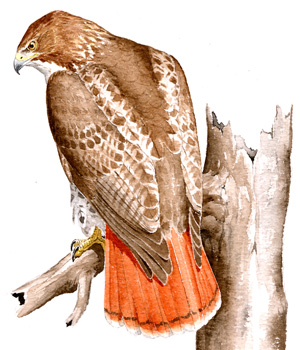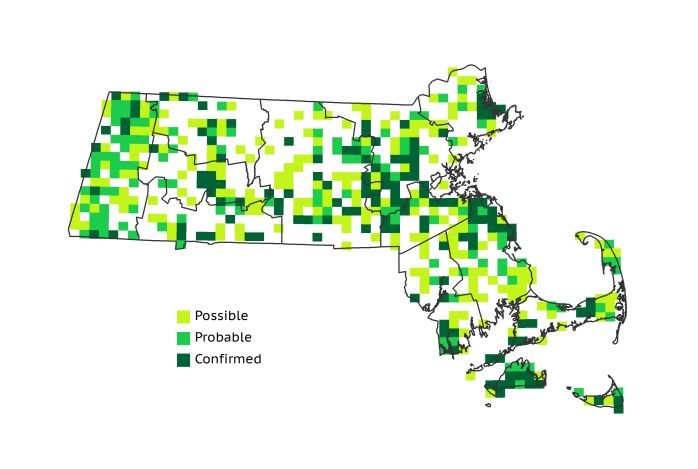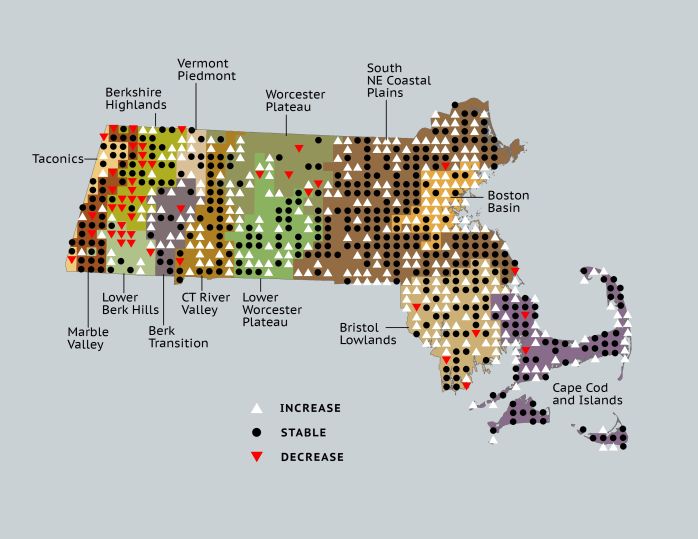Find a Bird
Red-tailed Hawk
Buteo jamaicensis

Nearly ubiquitous and likely increasing

“A red-tailed hawk rose high on an air current, calling out shrill, sequential rasps of raptor joy.” – Barbara Kingsolver, Prodigal Summer
With their broad wings, stocky build, and high-soaring habits, Red-tailed Hawks are very much the archetypal buteos. The members of the genus Buteo are also known colloquially as the Buzzard Hawks or simply Buzzards, setting them apart from the “true hawks” of the genus Accipiter. No hawk is more familiar to the casual birder in Massachusetts than this species, which can be found all across the Commonwealth. Though today they can be found in almost any field, town, or city, Red-tailed Hawks were once much more rarely encountered in the Bay State.
Historic Status
Right from the start, Red-tailed Hawks had two strikes against them. Building their nests in tall forest trees, they faced breeding habitat destruction when the European settlers began clearing the land for agricultural purposes. Secondly, because of their penchant for chicken stealing – hence the nickname “Hen Hawk” – they suffered persecution at the hands of farmers. Edward Howe Forbush had practically written the species off in his 1927 Birds of Massachusetts and Other New England States, noting that they could be found only in remote locales such as Martha's Vineyard and the extreme western portion of the state. “Like all our hawks it is destined to give way before the advance of modern civilization,” he lamented. Through the twentieth century, however, the species persevered, despite ongoing shooting and trapping (practices that were eventually outlawed), continued habitat loss, and the introduction of organochlorine pesticides like DDT into the food chain after World War II.
Atlas 1 Distribution
Gradually relieved of the heavy burdens of shooting and toxic pesticides, Red-tailed Hawks had rebounded and were fairly widespread from the Berkshires to Nantucket in Atlas 1. They were especially common wherever there was a good mix of mature forest and open habitat for hunting; they were found in almost 90% of the Marble Valleys blocks, despite not exceeding 60% occupancy in any neighboring ecoregion. The lingering effects of pesticide use and agricultural persecution likely kept Red-tails out of half the Connecticut River Valley blocks, and numbers remained lower across the Worcester Plateau area. The Coastal Plains’ mixture of young woods, suburbs, and regenerating farm fields were apparently more to the hawks’ liking, and they bred in 56% of blocks in that region. Red-tails were also fairly widespread in the Bristol/Narragansett Lowlands and the Cape and Islands regions, with near-total occupancy on Martha’s Vineyard.
Atlas 2 Distribution and Change
Though unquestionably an expanding species overall, Red-tailed Hawks displayed interesting distribution trends in Atlas 2. The Taconic Mountains and Berkshire Highlands lost Red-tailed Hawks in as many blocks as they gained; while in both the Marble Valleys and Berkshire Hills Red-tailed Hawks underwent notable overall reductions in distribution. These declines are notable, as the species is thriving in the rest of the state. In fact, Red-tailed Hawks did not disappear from more than four total blocks in any ecoregion from the Connecticut River Valley eastward, and were newly reported from over a dozen blocks in each region. Particular areas of growth were the Boston Basin, the Bristol/Narragansett Lowlands, and Cape Cod, where expanding development and road infrastructure have created a lot of the edge habitat where Red-tails hunt.
Atlas 1 Map

Atlas 2 Map

Atlas Change Map

Ecoregion Data
Atlas 1 | Atlas 2 | Change | ||||||
Ecoregion | # Blocks | % Blocks | % of Range | # Blocks | % Blocks | % of Range | Change in # Blocks | Change in % Blocks |
Taconic Mountains | 11 | 68.8 | 2.3 | 13 | 52.0 | 1.5 | 0 | 0.0 |
Marble Valleys/Housatonic Valley | 35 | 89.7 | 7.4 | 31 | 79.5 | 3.7 | -4 | -10.3 |
Berkshire Highlands | 33 | 60.0 | 7.0 | 35 | 63.6 | 4.1 | 0 | 0.0 |
Lower Berkshire Hills | 12 | 42.9 | 2.5 | 12 | 38.7 | 1.4 | -1 | -3.7 |
Vermont Piedmont | 6 | 35.3 | 1.3 | 17 | 100.0 | 2.0 | 6 | 50.0 |
Berkshire Transition | 12 | 31.6 | 2.5 | 29 | 72.5 | 3.4 | 13 | 41.9 |
Connecticut River Valley | 32 | 57.1 | 6.8 | 62 | 95.4 | 7.3 | 18 | 37.5 |
Worcester Plateau | 19 | 24.4 | 4.0 | 59 | 67.0 | 6.9 | 15 | 31.3 |
Lower Worcester Plateau | 34 | 45.9 | 7.2 | 69 | 86.3 | 8.1 | 21 | 38.9 |
S. New England Coastal Plains and Hills | 150 | 55.6 | 31.6 | 266 | 94.0 | 31.3 | 77 | 34.1 |
Boston Basin | 14 | 25.0 | 3.0 | 49 | 87.5 | 5.8 | 34 | 61.8 |
Bristol and Narragansett Lowlands | 47 | 44.3 | 9.9 | 90 | 78.9 | 10.6 | 40 | 39.6 |
Cape Cod and Islands | 69 | 50.7 | 14.6 | 117 | 81.3 | 13.8 | 40 | 33.3 |
Statewide Total | 474 | 48.9 | 100.0 | 849 | 81.9 | 100.0 | 259 | 31.2 |
Notes
The Red-tailed Hawk shows significant increasing Breeding Bird Survey trends, both in the mid-Atlantic region and the whole Eastern US.



